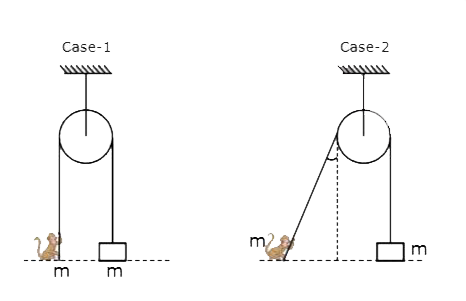In both the cases block & monkey are at the same horizontal level. In both the cases monkey climbs the rope.In case-1 rope remains vertical & in case-2 rope swing during motion. t1 & t2 are times taken by monkeys to reach the pulley in case - 1 & case -2 respectively. In both cases, monkey applies the same force on the rope.

t1=t2
t1<t2
In case-2, block reaches the pulley earlier than monkey
In case-I, monkey reaches the pulley earlier than block
The correct Answer is:B, C
Step by step video & image solution for In both the cases block & monkey are at the same horizontal level. In both the cases monkey climbs the rope.In case-1 rope remains vertical & in case-2 rope swing during motion. t_(1) & t_(2) are times taken by monkeys to reach the pulley in case - 1 & case -2 respectively. In both cases, monkey applies the same force on the rope. by Physics experts to help you in doubts & scoring excellent marks in Class 12 exams.
Updated on:21/07/2023Topper's Solved these Questions
- NLM & FRICTIONBOOK - MOTIONCHAPTER - NLM & FRICTIONEXERCISE - EXERCISE-3(Level-I)
18 Videos
- NLM & FRICTIONBOOK - MOTIONCHAPTER - NLM & FRICTIONEXERCISE - EXERCISE-3(Level-II)
12 Videos
- NLM & FRICTIONBOOK - MOTIONCHAPTER - NLM & FRICTIONEXERCISE - EXERCISE-2
66 Videos
- NEWTON'S LAWS OF MOTION & FRICTION BOOK - MOTIONCHAPTER - NEWTON'S LAWS OF MOTION & FRICTION EXERCISE - Exercise - 3 Section-B
12 Videos
- ONE DIMENSION MOTIONBOOK - MOTIONCHAPTER - ONE DIMENSION MOTIONEXERCISE - Exercise - 3 |Section - B Previous Year Problems | JEE MAIN
12 Videos
Similar Questions
A monkey of massm clings to a rope slung over a fixed pulley. The opposite end of the rope is tied to a weight of

mass M lying on a horizontal plat (Fig.). Neglecting friction find the acceleration of both bodies (relative to the plate) and the tension of the rope for the three cases:
(1) the monkey does not move with respect to the rope,
(2) the monkey moves upwards with respect to the rope with acceleration b,
(3) the monkey moves downwards with respect to the rope with an acceleration b.
View SolutionA monkey of mass m climbs up to a rope hung over a fixed pulley. The opposite end of the rope is tied to a weight of mass M lying on a horizontal plane. Neglecting the friction, find the acceleration of both the bodies (relative to the plane) and the tension of the rope for the three cases:
(i) The monkey does not move with respect to the rope
(ii) The monkey moves upwards with respect to the rope with acceleration a.
(iii) The monkey moves downwards with respect to the rope, with acceleration a.
View Solution
Knowledge Check
A cell to emf. E and internal resistance r supplies currents for the same time t through external resistanceR1andR2 respectively. If the heat produced in both cases is the same, then the internal resistance is given by :
A1r=1R1+1R2Br=R1+R22Cr=√R1R2Dr=R1+R2A projectile can have the same range R for two angles of projection. If t1 and t2 be the times of flight in the two cases:-
At1t2∝R2Bt1t2∝RCt1t2∝1RDt1t2∝1R2The masses of two monkeys are in the ratio 2:3 what will be the common acceleration for a monkey climbing up and another monkey climbing down a rope hanging from a tre with same uniform acceleration separately?
A6gBgCg/2Dg/3
For a given velocity, a projectile has the same range R for two angles of rpojection if t1 and t2 are the times of flight in the two cases then
View SolutionTwo blocks of mass m and 2m are kept in contact on a smooth horizontal surface. A horizontal pushing force F is applied on mass 2m in case I and on mass m in case II. Then the ratio of normal reaction between the blocks in case I to that in case II is :

View SolutionA projectile has same range for two angules of projection. If times of flight in two cases are t1andt2 then the range of the projectilie is
View SolutionThe case in which F1 generation resembles both parents is known as
View SolutionA monkey climbs up and another monkey climbs down a rope hanging from a tree with same uniform acceleration separately. If the respective masses of monkeys are in the ratio 2:3, the common acceleration must be
View Solution
